

|
UT-S 7-SEG R click Released

7-segment LED display is the most commonly used type of display to represent changing numerical values. The principle is very simple - seven LED segments are positioned in a certain shape and by turning specific segments on or off, the shape that resembles a specific number is lit. This method of displaying numbers was first used in the beginning of the 20th century, but after the invention of the LED in '70, it is the most commonly used method to display numbers. It utilizes a fairly simple and cheap design with the numbers clearly visible. Be it a clock on the nightstand, a billboard at the airport, a gauge on some machine, a panel on some instrument or a display on the pump at the gas station - the numbers will be always easy to see and read, even in the dark.
UT-S 7 SEG R click uses two SMD ultra-thin DSM7UA20101 7-SEG LED displays, made with the patented technology that delivers thickness of only 2.1 mm. These displays are driven by the MAX6969, a constant current LED integrated driver from Maxim Integrated, which uses the SPI serial interface for communication and delivers steady and constant power source for the LED segments. |
2017/12/20 |

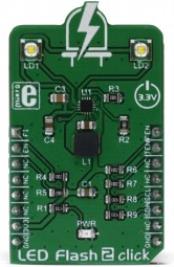
|
LED Flash 2 click Released

LED Flash 2 click is a powerful flash/torch click, featuring the MIC2870 from Microchip, a high-efficiency flash LED driver, optimized for driving one or two high-brightness camera flash LEDs. The MIC2870 IC can drive one high brightness LED up to 1.5A or two high brightness LEDs, up to 750mA each. Two high brightness LEDs are already mounted on the Led Flash 2 click, so the click board is ready to be used right away.
LED Flash 2 click provides two modes of operation - the Torch mode and the Flash mode. While working in Torch mode, the output current is adjusted so that the continuous operation of the LEDs is provided. When it is set to work in the Flash mode, the LED current is maximized and while giving a powerful light, it can not work for prolonged periods. The Torch mode will turn the click board™ into a simple handheld torchlight, while the Flash mode is good for using the LEDs as the camera flash, providing good images in various low light situations. |
2017/12/20 |

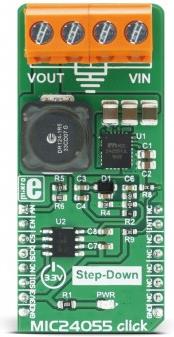
|
MIC24055 click Released

MIC24055 click is the buck regulator that can deliver continuous output current up to 8A and can step down voltages from up to 19V which makes this click board easy to use with many power sources commonly available. The amount of current it can deliver and the steady, ripple-free regulated voltage, make this click board a perfect choice for powering up devices which require high current, regulated power supply, such as servers and workstations, routers, telecom equipment and every other electronic device with similar power demands.
MIC24055 click is equipped with the MIC24055, high-efficiency buck regulator from Microchip. This IC can work with the wide range of input voltages, from 4.5V up to 19V. The regulated voltage at the output can be set from 1V to 4.8V by the means of the feedback (FB) pin and the second chip on board - MCP4921, a single channel 12-bit DAC by Microchip, equipped with the SPI interface. By programming the output of this DAC through the SPI interface routed to the mikroBUS socket pins, it is possible to easily set up the output voltage of the buck regulator. MikroElektronika libraries make it possible to perform this task easily, as seen in the example application. |
2017/12/20 |

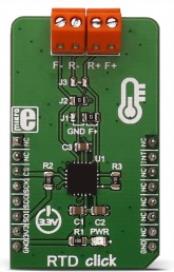
|
RTD click Released

RTD click is based on MAX31865 resistance to digital converter from Maxim Integrated, optimized for platinum resistance temperature detectors, or RTD. The click uses the PT100 type platinum probe for temperature measurement. There are four screw terminals on the board, so different PT100 probe types can be used with this design. This click board™ can work with 2, 3 or 4-wire PT100 probe types.
RTD probes are commonly used to measure a range of temperatures between -200°C and 500°C, but the exact value depends on the specific probes used. Features like the 15bit ADC resolution, input terminals overvoltage protection up to ±45V, fault detection, fast response time of 21mS and the SPI interface, make the RTD click an ideal solution when it comes to precise measuring of extremely high and low temperatures. |
2017/12/20 |

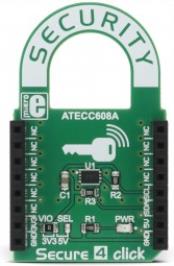
|
Secure 4 click Released

Secure 4 click includes the ATECC608A, a secure CryptoAuthentication™ device from Microchip, which is equipped with an EEPROM array which can be used for storing of up to 16 keys, certificates, consumption logging, security configurations and other types of secure data. Access to the various sections of memory can be restricted in several different ways and then the configuration can be locked permanently, to prevent changes.
The ATECC608A equipped on this click board™, supports the I2C interface with a flexible command set, that allows use in various security applications, including Network/IoT Node Endpoint Security, Secure Boot, Small Message Encryption, Key Generation for Software Download, Ecosystem control, Anti Counterfeiting and similar.
NOTE: The click board™ comes with stacking headers which allow you to combine it with other click boards™ more easily by using just one mikroBUS™ socket. |
2017/12/20 |


|
DHT22 2 click (Temperature / Humidity Sensor) Released

DHT22 2 click is used for measuring the environmental temperature and relative humidity. It uses the CM2322 sensor, with very accurate thermal and humidity measuring capabilities. It can use either 1-Wire or I2C protocol to communicate with the integrated circuit.
Attributes like the ultra-small size, low power consumption,data signal transmission distance up to 20 meters, make this sensor the perfect choice for all kinds of applications that require measurement of the temperature and humidity. |
2017/12/20 |

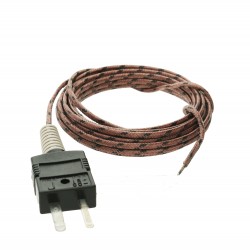
|
Thermocouple Type-J Probe Released

Type-J thermocouple with glass braid insulation is used for precise measurement of high temperatures. Thermocouple itself can measure up to 480°C (900°F). It is 2 meters long and ends with a PCC-SMP connector which is compatible with Thermo J click.
|
2017/12/20 |

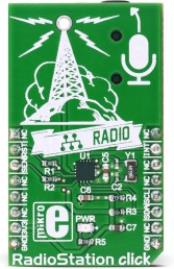
|
RadioStation click Released

RadioStation click is a unique click board™ that can be used to broadcast the music via the FM radio band. It features the Si4713-B30 from Silicon Labs, the best in class integrated FM broadcast stereo transmitter, which operates in the frequency range of 76MHz to 108MHz. It can also broadcast RDS/RDBS data. The click board™ can be equipped with a small FM antenna, which is used to extend the broadcasting range.
One of the advantages of this versatile FM broadcast stereo transmitter IC is that it needs almost no external components so it is very easy to work with it. That makes it an ideal solution for using it in cellular phones, MP3 players, portable media players, wireless speakers, personal computers and any other applications, where short-range radio broadcasting is wanted. |
2017/12/20 |

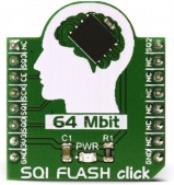
|
SQI FLASH click Released

SQI FLASH click is based on the SST26VF064B, a 64 Mbit Serial Quad I/O flash device from Microchip. The chip utilizes 4-bit multiplexed I/O serial interface to boost the performance. The click is a very fast solid-state, non-volatile data storage medium, that can be electrically erased and reprogrammed. Operating at 104 MHz, the SST26VF064B enables minimum latency execute-in-place (XIP) capability, without the need for the code shadowing.
Features like the high performance and reliability, make the SQI Flash click the ideal choice for network appliances, DSL and cable modems, wireless network devices, automotive and any other applications, where high-speed reliable data storage is needed. Further benefits are achieved with its proprietary, high-performance CMOS SuperFlash® technology, which significantly improves the performance and reliability and lowers the power consumption. |
2017/12/20 |


|
Proteus IoT Builder Released

IoT Builder is designed to make it quick and easy to control remote electronics from a mobile device. Design a front panel for your phone or tablet in our editor and then program the interaction of the UI controls with the hardware using simple Visual Designer flowchart blocks or C/C++.
|
2017/12/07 |


|
RS485 3 click Released

RS485 3 click uses SN65HVD31DR from Texas Instruments, a tri-state differential line driver and differential input line receiver. The click is intended to be used as UART to RS422/RS485 communication interface. It is suited for transmitting smaller blocks of data over long distances, using the four-wire bus, allowing for full-duplex communication.
It can be used as a transceiver between UART interface and RS422/RS485 communication bus. RS485 3 click can be used for controlling various building automation systems, light controllers, sensors and many small embedded devices that can all share the same bus, which can stretch up to 254 nodes and up to 1200m in length. |
2017/11/28 |

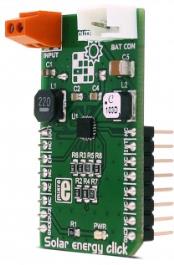
|
Solar Energy click Released

There are many battery chargers and solar energy harvesters out there already, but the Solar energy click has the unique feature - it encompasses both of these devices in a single package. The click uses Texas Instruments BQ25570 - a nano-power high-efficiency boost charger and buck converter device, designed to work with very low power energy harvesting elements, such as the photovoltaic and thermoelectric generators.
The Solar energy click recharges the connected LiPo battery or the onboard 220mF supercapacitor, using the photovoltaic element.This is done by utilizing the BQ25570's charging and power harvesting capabilities and clever nano-power management features. This click can also power up low power consumption devices by using the stored energy, providing a way for continuous power operation of low power devices.
These features make the Solar energy click an ideal solution for powering wireless sensor networks, environment monitoring devices, portable and wearable health monitoring devices and similar low power self-sustained devices. |
2017/11/28 |

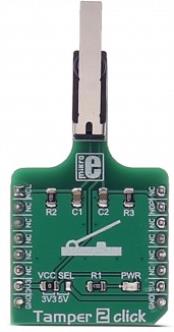
|
Tamper 2 click Released

Tamper 2 click contains a levered D2HW-A221D switch by Omron, which outputs signal in both positions - pressed and released. Omron switches, also known as microswitches, are well renowned for their reliability and endurance. The PCB of this click is designed so that the lever of the microswitch is easily accessible, making the click useful for all kinds of different applications, where precise, two position switches are required. Both the NO (Normally Open) and NC (Normally Closed) pins of the microswitch are routed to mikroBUS™, so it can be easily connected to the microcontroller.
Switches of this kind are widely used in many different applications. The most common use of Tamper 2 click is door opening or closing detection, detecting the end of travel of a linear actuator, a Morse code input device and so on. |
2017/11/28 |

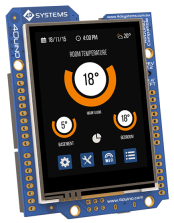
|
4Duino-24 Released

The 4Duino is an Arduino compatible display module with built in 2.4" 240x320 resolution TFT LCD Display with Resistive Touch, as well as Wi-Fi capabilities, perfect for IoT (Internet of Things) Applications.
|
2017/11/24 |


|
AnyNet 2G click Released

AnyNet 2G click is a cellular to AWS gateway device, which provides developers with the complete solution for various IoT applications, by using the AWS IoT and Cloud Storage services for the data storage, analyzing and processing.
This click board™ provides an easy and secure connection with the AWS over the air (OTA), by utilizing the equipped Quectel M95 module and Eseye ES4623 embedded SIM card, that can work with more than 235 cellular operators from all over the world. AnyNet 2G click can be used as an AWS IoT button with almost no configuration.
AnyNet 2G click comes supplied with the start-up package - free activation through the AWS, unique ID number of the embedded SIM card and six-month cellular connectivity services of up to 5000 messages to the AWS cloud. With the AnyNet 2G click, users get the unique level of integration with the AWS IoT services.
Note: Before the purchase of AnyNet 2G click, please contact Eseye and check for the coverage and support of embedded SIM cards from your local provider. Opening an AWS account and subscribing to Eseye marketplace is mandatory to work with this click board. |
2017/11/23 |


|
Tamper click Released

Tamper click is equipped with SDS001, a low profile side-actuated detect switch, made by C&K company. This is a high-quality, low-current detection switch, which is designed in a form of a push button. The switch itself is very small - only 2mm of switch overtravel length, which coupled with its low actuation force, makes it ideal for using it as a contact detector in various applications - consumer electronics devices, medical devices, smart card detection and similar applications.
Tamper click board™ is also additionally equipped with the RC filter that minimizes the bouncing effect, making this click a reliable solution for any contact detection application. |
2017/11/23 |


|
Contact Number Update

As of end November 2017, our old "Landline" number 011 022 5323 will be discontinued - please continue to use all of the other direct contact numbers which are available :-).
|
2017/11/22 |

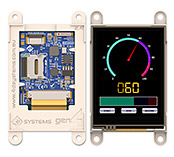
|
gen4-IoD (Internet of Displays) Released

The gen4-IoD (Internet of Displays) series of is part of the latest gen4 Range of modules Designed and Manufactured by 4D Systems.
The gen4 series was designed specifically for ease of integration and use, with careful consideration for space requirements and functionality.
This specific gen4 module features a 2.4", 2.8" or a 3.2" colour TFT LCD display, with Resistive Touch. It is powered by the WiFi enabled ESP8266, which offers an array of functionality and options for any Designer / Integrator / User.
|
2017/11/21 |

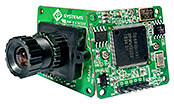
|
MicroCAM 3 (uCAM-III) Released

MicroCAM 3 (uCAM-III)
The uCAM-III (microCAM-III) is a highly integrated serial camera module which can be attached to any host system that requires a video camera or a JPEG compressed still camera for embedded imaging applications, and is the new upgrade to the popular uCAM-II, which is backwards compatible but includes some additional features.
|
2017/11/21 |


|
LED driver 2 click Released

LED driver 2 click carries the MCP1643 - LED constant current regulator, made by Microchip. It is a compact, high-efficiency, fixed frequency, synchronous step-up converter, optimized to drive one LED with the constant current. It can be powered by a two-cell alkaline/NiMH/NiCd battery (2.4V), or via the mikroBUS™ power supply pins. LED Driver 2 click also features 3W high power LED by QT-Brightek. This LED can be dimmed by applying the variable duty cycle PWM signal to the EN pin of the MCP1643 regulator, through the PWM pin of the mikroBUS™.
Thanks to its relatively high constant current driving capability and the overvoltage protection on the output, this integrated circuit is perfectly suited for high brightness/power LED applications: portable LED lighting products, LED Flashlight and Head Lamps, Rechargeable Flashlights, General LED constant current applications and so on.
|
2017/11/19 |

|

